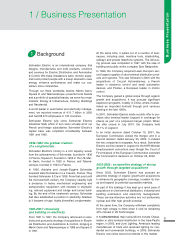APC 2005 Annual Report Download - page 21
Download and view the complete annual report
Please find page 21 of the 2005 APC annual report below. You can navigate through the pages in the report by either clicking on the pages listed below, or by using the keyword search tool below to find specific information within the annual report.
19
Our strategy involves growth
through acquisitions, joint ventures and
mergers, which may be difficult to identify
and/or execute
Our strategy involves strengthening our capabilities
through acquisitions, strategic alliances, joint ventures
and mergers.Transactions such as these are inherent-
ly risky because of the difficulties that may arise in
integrating people, operations, technologies and prod-
ucts, and the related acquisition, administrative and
other costs.
We have therefore developed a process for integrating
newly-acquired businesses. The process extends over
a period of 6 to 24 months depending on the type and
size of the new entity and comprises six clearly-iden-
tified phases, which are described in the Group’s inter-
nal procedure manuals. The integration scenario for
each acquisition varies depending on whether the
business was acquired to strengthen the Group’s
existing lineup, extend the lineup or penetrate a new
segment. All told, there are five scenarios ranging
from total integration to separate organization.
Depending on the strategic objective, a matrix is
drawn up showing the required level of integration for
each of the newly-acquired business’s core functions,
i.e. front office (sales force and brand), back office,
R&D, corporate functions and management reporting.
An integration plan is drawn up for each acquisition
and is implemented by an integration manager who
reports to a Steering Committee. The Steering Com-
mittee meets monthly during the integration plan
development phase, and quarterly once the integra-
tion plan has been approved.
We may be adversely
affected by rising raw material prices
We are exposed to fluctuations in energy and raw
material prices (in particular steel, copper, aluminum,
silver, nickel and zinc). If we are not able to hedge,
compensate or pass on our increased costs to cus-
tomers, this could have an adverse impact on our
financial results.
We have, however, implemented certain procedures
to limit our exposure to rising non-ferrous raw materi-
al prices. The purchasing departments of the operat-
ing units report their purchasing forecasts to the Cor-
porate Treasury Center twice a year. Purchase com-
mitments are hedged using forward contracts, swaps
and, to a lesser extent, options.
We are dependent upon hiring
and retaining highly qualified management
and technical personnel
Competition for highly qualified management and
technical personnel is intense in our industry. Our
future success depends in part on our ability to hire,
assimilate and retain engineers and other qualified
personnel.
Our human resources strategy is designed to create a
motivating working environment. Specific policies have
been developed covering international mobility, career
development, training and compensation. By posting
employees outside their home countries, we are able
to prepare the future and build teams and skills in
regions in which we want to operate. We also use train-
ing to develop skills and nurture employee loyalty.
We may be the subject of product liability
claims and other adverse effects due to
defective products, failure to operate properly
or harm caused to persons and property
Regardless of testing and quality procedure, our prod-
ucts might not operate properly or might contain errors
and defects. These errors and defects could result in
product liability claims, loss of revenue, warranty
claims, litigation, delay in market acceptance or harm
to our reputation for safety and quality. To prevent or
limit these risks, we recall products if there are any
doubts about a component, even if the defect is ran-
dom and does not pose a safety risk.
Schneider Electric is covered by a global liability insur-
ance program. Specific liability programs have been
set up in the United States, Canada and Mexico to
take account of the specific requirements and charac-
teristics of the North American market. Insured values
under these programs adequately cover the Group's
exposure to liability claims in connection with its busi-
nesses.
The development and success of our
products depends on our ability to protect
our intellectual property
Our future success depends to an extent on the devel-
opment and maintenance of our intellectual property
rights. Third parties may infringe our intellectual prop-
erty rights, and we may expend significant resources
monitoring, protecting and enforcing our rights. If we
fail to protect or enforce our intellectual property
rights, our competitive position could suffer, which
could have an adverse effect on our business.
In order to mitigate this risk, the patents developed or
purchased by the Group are tracked by the Industrial
Property team within the Finance & Control - Legal
Affairs Department. All industrial property information
for the main Group subsidiaries is transmitted to this
team, which is responsible for managing and protect-
ing these intangible assets throughout the world. The
same procedure is followed for trademarks.
In 2005, the Group decided to combat violations of
industrial property rights more vigorously, taking legal
action against patent counterfeiters in Germany, Italy,
France and other jurisdictions.
Our plants and products
are subject to environmental regulations
Our plants and products are subject to extensive and
increasingly stringent environmental laws and regula-
tions in all our host countries. In order to limit risks
related the environment generally, we are involved in
a process to continuously improve the environmental
performance of our plants and products.
Business Presentation
























